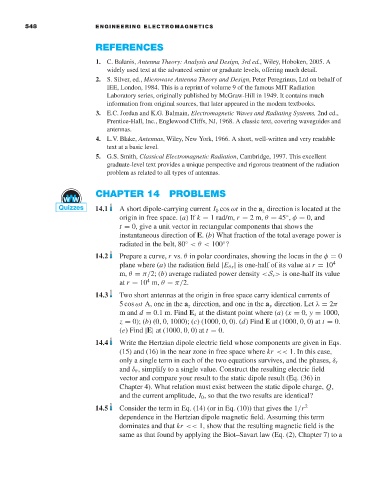Page 566 - Engineering Electromagnetics, 8th Edition
P. 566
548 ENGINEERING ELECTROMAGNETICS
REFERENCES
1. C. Balanis, Antenna Theory: Analysis and Design, 3rd ed.,Wiley, Hoboken, 2005. A
widely used text at the advanced senior or graduate levels, offering much detail.
2. S. Silver, ed., Microwave Antenna Theory and Design, Peter Peregrinus, Ltd on behalf of
IEE, London, 1984. This is a reprint of volume 9 of the famous MIT Radiation
Laboratory series, originally published by McGraw-Hill in 1949. It contains much
information from original sources, that later appeared in the modern textbooks.
3. E.C. Jordan and K.G. Balmain, Electromagnetic Waves and Radiating Systems, 2nd ed.,
Prentice-Hall, Inc., Englewood Cliffs, NJ, 1968. A classic text, covering waveguides and
antennas.
4. L.V. Blake, Antennas,Wiley, New York, 1966. A short, well-written and very readable
text at a basic level.
5. G.S. Smith, Classical Electromagnetic Radiation, Cambridge, 1997. This excellent
graduate-level text provides a unique perspective and rigorous treatment of the radiation
problem as related to all types of antennas.
CHAPTER 14 PROBLEMS
14.1 A short dipole-carrying current I 0 cos ωt in the a z direction is located at the
origin in free space. (a)If k = 1 rad/m, r = 2m, θ = 45 , φ = 0, and
◦
t = 0, give a unit vector in rectangular components that shows the
instantaneous direction of E.(b) What fraction of the total average power is
radiated in the belt, 80 <θ < 100 ?
◦
◦
14.2 Prepare a curve, r vs. θ in polar coordinates, showing the locus in the φ = 0
plane where (a) the radiation field |E θs | is one-half of its value at r = 10 4
m, θ = π/2; (b)average radiated power density <S r > is one-half its value
4
at r = 10 m, θ = π/2.
14.3 Two short antennas at the origin in free space carry identical currents of
5 cos ωt A, one in the a z direction, and one in the a y direction. Let λ = 2π
m and d = 0.1m. Find E s at the distant point where (a)(x = 0, y = 1000,
z = 0); (b)(0, 0, 1000); (c) (1000, 0, 0). (d) Find E at (1000, 0, 0) at t = 0.
(e) Find |E| at (1000, 0, 0) at t = 0.
14.4 Write the Hertzian dipole electric field whose components are given in Eqs.
(15) and (16) in the near zone in free space where kr << 1. In this case,
only a single term in each of the two equations survives, and the phases, δ r
and δ θ , simplify to a single value. Construct the resulting electric field
vector and compare your result to the static dipole result (Eq. (36) in
Chapter 4). What relation must exist between the static dipole charge, Q,
and the current amplitude, I 0 ,so that the two results are identical?
14.5 Consider the term in Eq. (14) (or in Eq. (10)) that gives the 1/r 2
dependence in the Hertzian dipole magnetic field. Assuming this term
dominates and that kr << 1, show that the resulting magnetic field is the
same as that found by applying the Biot–Savart law (Eq. (2), Chapter 7) to a

